Since bicentennials are a once-in-a-lifetime experience, my Dear One and I found it impossible to ignore the “Star-Spangled Sailabration” of the War of 1812.
That war is one of those conflicts largely ignored in American education. We’re very big on the War for Independence but leapfrog the War of 1812 to get to the Civil War, then we ignore World War One and head straight for World War Two. Maybe we just like the four-score interval: four-score and five between 1776 and 1861, four-score on the nose from 1861 to 1941.
Much like politics, however, history is local. In Maryland we’re very big on the troubles of 1812.
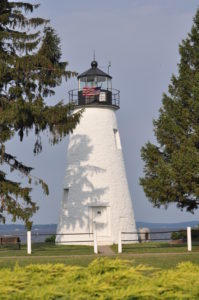
Concord Point lighthouse
The town of Havre de Grace, an erstwhile contestant for the nation’s capital, reenacts the British raid of May 3, 1913 each year, complete with costumes and boats and things that go boom. The story of Lieutenant John O’Neill’s determined fight, capture, and eventual release due to the courageous intervention of his 15-year-old daughter Matilda is legendary. O’Neill became the first keeper of the Concord Point lighthouse, a sinecure awarded for his gallantry—and the lighthouse remains perhaps the best-known tourist site in the area.
Then, of course, there is Baltimore’s Fort McHenry, the Battle of Baltimore, and the immortal lines penned by Francis Scott Key. On 13 September 1814, having just left much of Washington, D.C. in ashes, British ships began a bombardment of the fort that would last more than a day—a long, rain-drenched day. Despite their superior artillery strength, the British did not prevail; the signing of the Treaty of Ghent on Christmas Eve a few months later marked the end of the war. At dawn on the 14th, Major Armistead ordered the small storm flag flying over Fort McHenry replaced with the much larger garrison flag. It was this flag that Key saw from a ship anchored some eight miles distant where he was briefly under detention. His poem, “The Defence of Fort McHenry,” set to the tune of a popular drinking song “Anacreon on Heaven” was subsequently retitled “The Star-Spangled Banner.”
The two-hundredth anniversary of the beginning of the war has been acknowledged throughout the area. (Will there be additional events in 2013 and 2014 to celebrate particular anniversaries? Probably.)
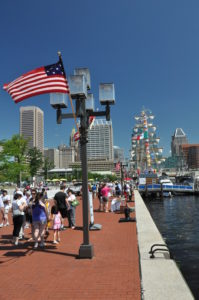
A Sailabration at Baltimore’s Inner Harbor
So we went down on a Friday to take it all in. The ships—tall ships and battleships—arrived the Wednesday prior, but schedule conflicts and general ochlophobia kept us away. We thought we might find a spot by sunrise on Tuesday when the vessels leave, and we may still. Friday, however, was a beautiful day, blue skies, tolerable humidity, a pleasant breeze, and space sufficient to navigate the piers and sidewalks of the Inner Harbor.
The tall ships were certainly spectacular, even though we did not board. (Part of our ochlophobia is our impatience with waiting in lines.) Everywhere were sailors in dress whites, volunteers eager to offer maps and welcome, visitors and locals; music, both live and canned, brought rhythm to our stroll. There were souvenir vendors aplenty and the stores, hotels and restaurants appeared to be doing good business. We missed the “Pride Of Baltimore,” though, oddly absent from its designated berth on Pier 1. Sigh.
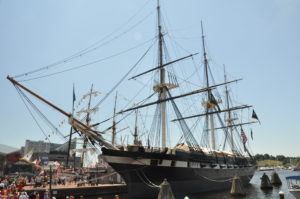
“Constellation”
I learned the odd fact as well. I did not know, for instance, that the ship “Exodus” immortalized in the novel by Leon Uris was launched in Baltimore as a packet steamer serving ports along the Chesapeake Bay. While I remembered that the “Constellation,” sister ship to Boston’s “Constitution,” was anchored in the harbor, I didn’t know about the submarine and other ships that one can also tour. I haven’t been to the National Aquarium or the Science Center in perhaps twenty years, although I occasionally make it to the American Visionary Artists Museum (AVAM) behind the harbor on Key Highway.
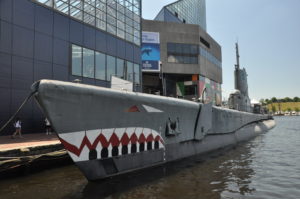
USS “Torsk”
It even occurred to us that we could celebrate a Father’s Day (Father’s Day being tomorrow) or Mother’s Day by renting a suite at one of the hotels, dining at one of the restaurants famed for crab cakes, then turning the grandchildren loose for a couple of hours to roam and play before reconvening for dessert.
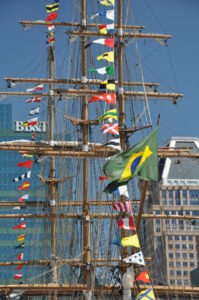
tall ship “Cisne Branco,” tall buildings Baltimore
It certainly occurred to us that we need to get into Baltimore more often.
Baltimore looks to me more often like a set from “The Wire.” My route from southbound Interstate 95 to the Maryland Institute College of Art campus in Bolton Hill takes me past block after block of derelict rowhouses.
Baltimore apparently just dropped out of the top five of America’s most dangerous cities—now it is number six. It is true that is a balkanized community with considerable racial anxiety. It is a poor city with a population that declined precipitously at the end of the twentieth century. It is a city where I am always careful and vigilant after dark.
But Charm City has many reasons for that moniker.
If more of Baltimore looked and felt more like this, in terms of energy, optimism, and confidence, it would look a lot less like the gritty setting of those well written and brilliantly cast television dramas.
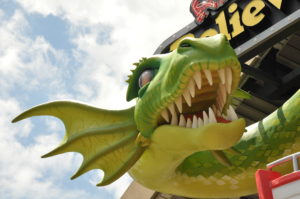
Ripley’s dragon
